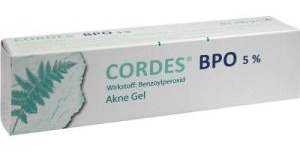
Bpo 5% Gel
Ingredients overview
Highlights
Key Ingredients
Other Ingredients
Skim through
| Ingredient name | what-it-does | irr., com. | ID-Rating |
|---|---|---|---|
| Benzoylperoxid (5%) | anti-acne | ||
| Aqua | solvent | ||
| Carbomer | viscosity controlling | 0, 1 | |
| Natriumhydroxid | buffering | ||
| Propylenglycol | moisturizer/humectant, solvent | 0, 0 |
Cordes Bpo 5% GelIngredients explained
The gold standard topical ingredient in treating acne. There is no miracle cure for acne (we do really wish for one, *sigh*), but Benzoyl Peroxide (BP) is probably the closest thing we have. But, as usual, big effects come with big side effects, so we think BP is best used as a last resort (at least, in the topical treatment field).
The good thing about BP is that it is amazingly effective against inflammatory-type acne. Not so much against blackheads or whiteheads, but against acne that is caused by the evil bacteria called Propionibacterium acnes (and that is most types of acne). Apart from being antibacterial, it is also anti-inflammatory, keratolytic and wound-healing, all of which are properties that make it so darn effective against spots.
Another big pro of BP is that there is no bacterial resistance to it, meaning if it works once it will continue to work. Antibiotics are also a common way to treat acne, but antibiotic-resistant P. acnes are increasing worldwide. BP will probably help you even if antibiotics have stopped working, and the two are also often combined for a more complex acne therapy. Btw, BP plays nice not only with antibiotics but also with retinoids.
The side-effects part? BP works its antibacterial magic by being a powerful oxidizing agent, meaning it is a pro-oxidant. As in the opposite of an antioxidant. BP literally generates evil ROS (reactive oxygen species) in the skin that kills P. acnes but also harms the surrounding skin cells. Ongoing BP-use ages your skin, which is why, we say, use it as a last resort. If you do use BP, please also use a good sunscreen and a good antioxidant serum to apologise to your skin (btw, these things are useful in any case). Use the BP treatment at night and the antioxidant serum in the morning so that they do not cancel each other out.
Another side effect of BP is that it can be very skin drying. BP is an example where more is not better. In fact, it is equally effective at concentrations of 2.5, 5.0 and 10%, but the higher the concentration the more irritating and drying side effects occur. So using BP at 2.5% percent is the ideal amount. Another side effect which is good to know is that BP can bleach bedsheets and clothes. Be careful with your expensive satin bedsheets.
Overall, Benzoyl Peroxide is a uniquely effective topical acne treatment, but it comes at a price. Use it as a last resort and for good measure (and with plenty of moisturizers, sunscreen, and antioxidant serum).
Good old water, aka H2O. The most common skincare ingredient of all. You can usually find it right in the very first spot of the ingredient list, meaning it’s the biggest thing out of all the stuff that makes up the product.
It’s mainly a solvent for ingredients that do not like to dissolve in oils but rather in water.
Once inside the skin, it hydrates, but not from the outside - putting pure water on the skin (hello long baths!) is drying.
One more thing: the water used in cosmetics is purified and deionized (it means that almost all of the mineral ions inside it is removed). Like this, the products can stay more stable over time.
A big molecule created from repeated subunits (a polymer of acrylic acid) that magically converts a liquid into a nice gel formula. It usually has to be neutralized with a base (such as sodium hydroxide) for the thickening to occur and it creates viscous, clear gels that also feel nice and non-tacky on the skin. No wonder, it is a very popular and common ingredient. Typically used at 1% or less in most formulations.
The unfancy name for it is lye. It’s a solid white stuff that’s very alkaline and used in small amounts to adjust the pH of the product and make it just right.
For example, in case of AHA or BHA exfoliants, the right pH is super-duper important, and pH adjusters like sodium hydroxide are needed.
BTW, lye is not something new. It was already used by ancient Egyptians to help oil and fat magically turn into something else. Can you guess what? Yes, it’s soap. It still often shows up in the ingredient list of soaps and other cleansers.
Sodium hydroxide in itself is a potent skin irritant, but once it's reacted (as it is usually in skin care products, like exfoliants) it is totally harmless.
- It's a helper ingredient that improves the freeze-thaw stability of products
- It's also a solvent, humectant and to some extent a penetration enhancer
- It has a bad reputation among natural cosmetics advocates but cosmetic scientists and toxicology experts do not agree (read more in the geeky details section)
You may also want to take a look at...
| what‑it‑does | anti-acne |
| what‑it‑does | solvent |
| what‑it‑does | viscosity controlling |
| irritancy, com. | 0, 1 |
| what‑it‑does | buffering |
| what‑it‑does | moisturizer/humectant | solvent |
| irritancy, com. | 0, 0 |





